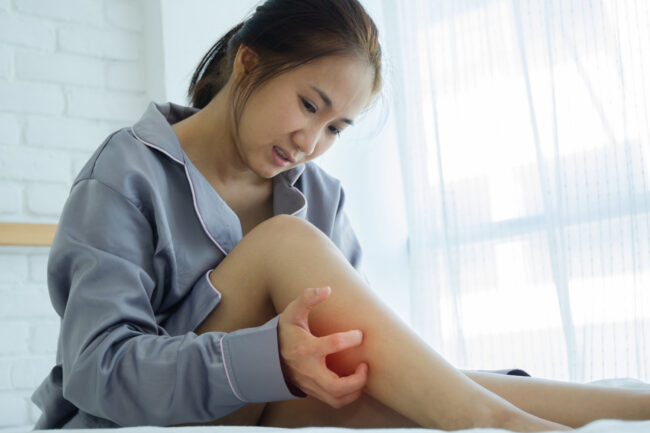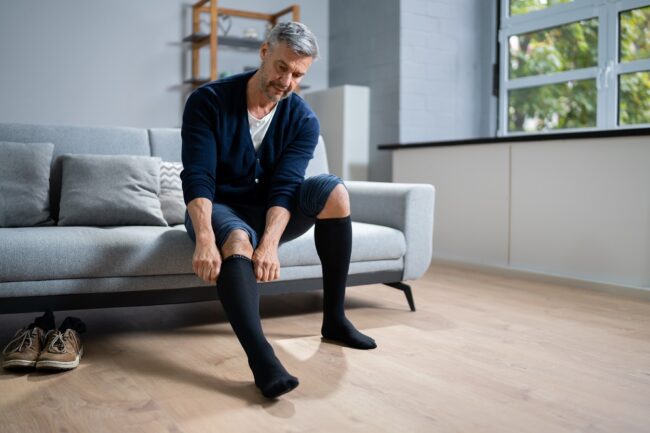“Bad” blood clots (also known as DVT or thrombi) can form for many reasons. And while flying is known to increase your risk of developing one, there are a few other factors at play. So, here’s how to travel safely with varicose veins.
Why are people more likely to get clots while flying in the first place?
When you’re on a long flight, you’re not moving around much. Your muscles can’t help your circulatory system push blood around your body, so your circulation slows. This slowing is why some people get swollen legs and others might get a thrombus (more commonly known as a blood clot).
Slow-moving blood thickens your blood cells and makes it more likely that they’ll stick together and clot. Unfrotunately, some conditions, habits, and natural processes increase the chances of a thrombus forming on a flight. These include:
- Being a smoker, as the habit damages the lining of your blood vessels and makes it more likely for blood cells to stick together.
- A recent injury or surgery. Your body might still be healing, and clots are a natural part of the healing process.
- Being over 40. The natural wear and tear on your vein walls and valves over time makes it easier for blood to pool (a condition known as reflux) and clot.
- Varicose veins. Slow-moving, pooling blood thickens cells, making them more likely to clump and form clots.
- Clotting disorders. If you have Factor V Leiden, antithrombin deficiency, protein S or C deficiency, or another clotting disorder, you’ll be more at risk while flying.
- When oestrogen levels fluctuate, like during pregnancy, hormone replacement therapy, or when you’re taking oestrogen-based contraceptives. Your vein walls require a steady amount of oestrogen to stay strong. So when the amount of oestrogen in your body changes, your vein walls can weaken, leaving you more prone to slower blood flow and clots.
Recognising the symptoms

Woman clutching her reddened calf in pain, common symptoms of a blood clot.
Because a thrombus can turn dangerous, you need to know how to recognise the symptoms. These include:
- Pain or tenderness
- Swelling
- Too-warm skin in a certain area
- A reddish patch on your skin
If a thrombus is causing a pulmonary embolism (i.e., it has dislodged from a deep vein wall and travelled into your lungs or heart), you’ll likely experience:
- Shortness of breath, which will typically happen suddenly and worsen with exertion
- Chest pain
- Cough, which may become bloody
- Pain or swelling in the leg, usually in the calf region
Other pulmonary embolism symptoms may include:
- Skin discolouration
- Excessive sweating
- Rapid or irregular heartbeat
- Dizziness or light-headedness
If you start feeling any of the above symptoms, notify the flight attendants immediately.
Minimising your chances of getting a blood clot on a flight

Man Putting On Medical Compression Stockings On Legs
Fortunately, there are some steps you can take to minimise your chances of getting a blood clot on a flight:
Move around as much as possible.
To reduce your DVT risk, you can take “mini-breaks” by standing up and walking in the aisles of the aeroplane every couple of hours.
Wiggle your toes and lift your legs up and down frequently to keep your circulation moving.
Avoid sitting too long in one position or with your legs crossed. Another tip is to massage your calf muscles periodically to increase the blood circulation in your legs. (Find out more: 7 exercises to keep your legs healthy while travelling)
Keep well hydrated.
Poor blood circulation coupled with high-altitude, pressurised cabin air can be very bad news if you’re prone to vein disease or want to prevent it. Make sure to bring along a bottle of water and sip from it often.
Staying well-hydrated will help stabilise your blood pressure and flow.
Avoid alcohol and sleeping tablets.
However tempting it may be to have a few drinks or take a pill to help you sleep, both hinder your circulation and in turn, increase your DVT risk. Also, avoid consuming coffee, as it can be extremely dehydrating.
Wear compression stockings to travel safely with varicose veins.
Your vein doctor or local pharmacist can recommend medical-grade compression stockings to wear during your flight. These stockings put gentle pressure on the leg muscles and improve circulation.
These special garments are designed to make you more comfortable during your flight by applying gentle pressure on your lower legs. This is done in a strategic way to promote circulation and prevent blood from pooling or refluxing.
Keep in mind that it’s very important to wear your compression garments correctly. Poorly fitted stockings could further increase your risk of developing complications such as DVT. (Find out more: non-medical options for managing varicose veins)
If you have varicose veins, have them assessed.
Varicose veins are bulging veins where blood pools. As circulation in these veins is slow, they make it more likely for blood cells to cluster and stick together into a clot.
Wear loose-fitting clothing
Tight clothes constrict the veins, allowing less room for blood to flow through. So, aim to wear loser garments to minimise the risk of blood cells clustering and clumping in one spot,
Delay a flight if it has been less than 3 months after a major injury or surgery
Injuries and surgeries prompt clotting as a healing response, so you’ll be more prone to DVT, thrombi, and general clots as the area heals.
Seek specialist advice
Before you take off, It’s important to consult your doctor if you’re at risk of clotting. It’s also important to get your varicose veins treated. After treatment, you may still need to avoid long-haul flights for 2-3 weeks to accommodate check-ups and ensure an easy recovery. But, it’s a good preventative measure to travel safely with varicose veins and avoid the risk of a blood clot while flying. If you’re ready to take the next step, call us at 13 VEINS (that’s 13 83467) or fill out the form below to book your consultation.

